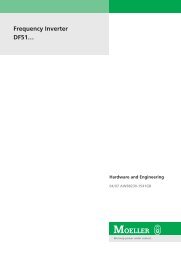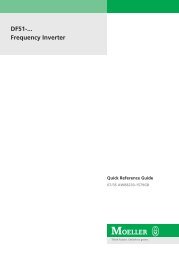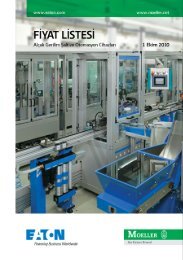- Page 1 and 2:
Hardware a
- Page 3 and 4:
• All covers and
- Page 5 and 6:
Contents01/02 AWB8230-1413GB4 Opera
- Page 7 and 8:
Contents01/02 AWB8230-1413GB- Contr
- Page 9 and 10:
601/02 AWB8230-1413GB
- Page 11 and 12:
About the DF6 <str
- Page 13 and 14:
About the DF6 <str
- Page 15 and 16:
About the DF6 <str
- Page 17 and 18:
Engineering01/02 A
- Page 19 and 20:
Engineering01/02 A
- Page 21 and 22:
Engineering01/02 A
- Page 23 and 24:
Installation01/02 AWB8230-1413GBMou
- Page 25 and 26:
Installation01/02 AWB8230-1413GBWit
- Page 27 and 28:
Installation01/02 AWB8230-1413GBFit
- Page 29 and 30:
Installation01/02 AWB8230-1413GBEle
- Page 31 and 32:
Installation01/02 AWB8230-1413GBCon
- Page 33 and 34:
Installation01/02 AWB8230-1413GBThe
- Page 35 and 36:
Installation01/02 AWB8230-1413GBPES
- Page 37 and 38:
Installation01/02 AWB8230-1413GBCon
- Page 39 and 40:
Installation01/02 AWB8230-1413GBPar
- Page 41 and 42:
Installation01/02 AWB8230-1413GBCon
- Page 43 and 44:
Installation01/02 AWB8230-1413GBNo.
- Page 45 and 46:
Installation01/02 AWB8230-1413GBhRo
- Page 47 and 48: Installation01/02 AWB8230-1413GBHav
- Page 49 and 50: Operating the DF60
- Page 51 and 52: Operating the DF60
- Page 53 and 54: Operating the DF60
- Page 55 and 56: Operating the DF60
- Page 57 and 58: Programming the ControlSignal Termi
- Page 59 and 60: Programming the ControlSignal Termi
- Page 61 and 62: Programming the ControlSignal Termi
- Page 63 and 64: Programming the ControlSignal Termi
- Page 65 and 66: Programming the ControlSignal Termi
- Page 67 and 68: Programming the ControlSignal Termi
- Page 69 and 70: Programming the ControlSignal Termi
- Page 71 and 72: Programming the ControlSignal Termi
- Page 73 and 74: Programming the ControlSignal Termi
- Page 75 and 76: Programming the ControlSignal Termi
- Page 77 and 78: Programming the ControlSignal Termi
- Page 79 and 80: Programming the ControlSignal Termi
- Page 81 and 82: Programming the ControlSignal Termi
- Page 83 and 84: Programming the ControlSignal Termi
- Page 85 and 86: Programming the ControlSignal Termi
- Page 87 and 88: Programming the ControlSignal Termi
- Page 89 and 90: Programming the ControlSignal Termi
- Page 91 and 92: Programming the ControlSignal Termi
- Page 93 and 94: Programming the ControlSignal Termi
- Page 95 and 96: Programming the ControlSignal Termi
- Page 97: Programming the ControlSignal Termi
- Page 101 and 102: Programming the ControlSignal Termi
- Page 103 and 104: Programming the ControlSignal Termi
- Page 105 and 106: 10201/02 AWB8230-1413GB
- Page 107 and 108: Setting Parameters01/02 AWB8230-141
- Page 109 and 110: Setting Parameters01/02 AWB8230-141
- Page 111 and 112: Setting Parameters01/02 AWB8230-141
- Page 113 and 114: ......Setting Parameters01/02 AWB82
- Page 115 and 116: Setting Parameters01/02 AWB8230-141
- Page 117 and 118: Setting Parameters01/02 AWB8230-141
- Page 119 and 120: Setting Parameters01/02 AWB8230-141
- Page 121 and 122: Setting Parameters01/02 AWB8230-141
- Page 123 and 124: Setting Parameters01/02 AWB8230-141
- Page 125 and 126: Setting Parameters01/02 AWB8230-141
- Page 127 and 128: Setting Parameters01/02 AWB8230-141
- Page 129 and 130: Setting Parameters01/02 AWB8230-141
- Page 131 and 132: Setting Parameters01/02 AWB8230-141
- Page 133 and 134: Setting Parameters01/02 AWB8230-141
- Page 135 and 136: Setting Parameters01/02 AWB8230-141
- Page 137 and 138: Setting Parameters01/02 AWB8230-141
- Page 139 and 140: Setting Parameters01/02 AWB8230-141
- Page 141 and 142: Setting Parameters01/02 AWB8230-141
- Page 143 and 144: Setting Parameters01/02 AWB8230-141
- Page 145 and 146: Setting Parameters01/02 AWB8230-141
- Page 147 and 148: Setting Parameters01/02 AWB8230-141
- Page 149 and 150:
Setting Parameters01/02 AWB8230-141
- Page 151 and 152:
Setting Parameters01/02 AWB8230-141
- Page 153 and 154:
Setting Parameters01/02 AWB8230-141
- Page 155 and 156:
Messages01/02 AWB8230-1413GBDisplay
- Page 157 and 158:
Messages01/02 AWB8230-1413GBOther m
- Page 159 and 160:
Messages01/02 AWB8230-1413GBDisplay
- Page 161 and 162:
Troubleshooting01/02 AWB8230-1413GB
- Page 163 and 164:
Appendix01/02 AWB8230-1413GB<strong
- Page 165 and 166:
Appendix01/02 AWB8230-1413GB<strong
- Page 167 and 168:
Appendix01/02 AWB8230-1413GBCables
- Page 169 and 170:
Appendix01/02 AWB8230-1413GBRFI fil
- Page 171 and 172:
Appendix01/02 AWB8230-1413GBPNU Fun
- Page 173 and 174:
Appendix01/02 AWB8230-1413GBPNU Fun
- Page 175 and 176:
Appendix01/02 AWB8230-1413GBPNU Fun
- Page 177 and 178:
Appendix01/02 AWB8230-1413GBPNU Fun
- Page 179 and 180:
Appendix01/02 AWB8230-1413GBPNU Fun
- Page 181 and 182:
Appendix01/02 AWB8230-1413GBPNU Fun
- Page 183 and 184:
Index01/02 AWB8230-1413GBFlow contr







